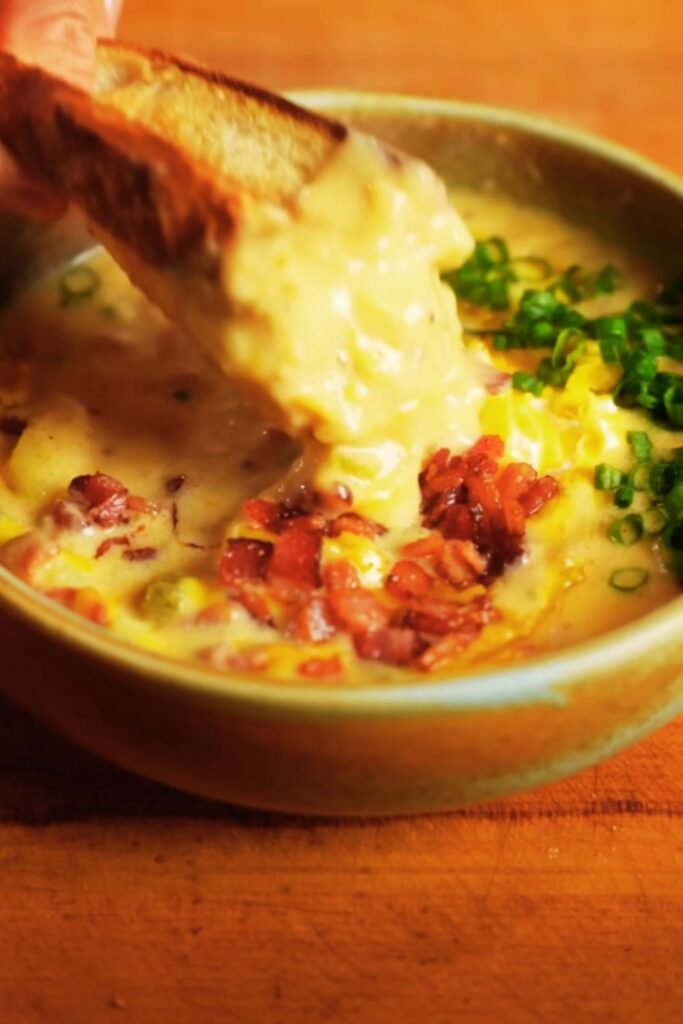There’s something truly magical about a steaming bowl of potato leek soup on a chilly evening. I’ve been perfecting this recipe for years, and I can honestly say it never fails to warm both body and soul. This isn’t just any ordinary soup – it’s a velvety, luxurious creation that transforms humble ingredients into something absolutely extraordinary.
I remember the first time I attempted potato leek soup. It was a disaster – watery, bland, and frankly embarrassing. But through countless trials and tribulations in my kitchen, I’ve discovered the secrets that transform this simple combination into a restaurant-quality masterpiece. Today, I’m sharing every single trick I’ve learned along the way.
Understanding the Stars: Potatoes and Leeks
Before we dive into the cooking process, let me explain why this particular combination works so beautifully together.
Potatoes: The foundation of our soup : Starchy potatoes like Russets break down beautifully during cooking, creating natural thickness without heavy cream : Waxy potatoes like Yukon Gold maintain their structure while still contributing creaminess : The starch content acts as both thickener and texture enhancer
Leeks: The sophisticated onion cousin : Milder and sweeter than regular onions, with complex flavor notes : The white and light green parts provide the best flavor balance : Requires careful cleaning due to dirt trapped between layers
Complementary Herbs and Seasonings : Fresh thyme adds earthy sophistication : Bay leaves contribute depth and complexity : White pepper maintains the soup’s pristine appearance : Nutmeg provides subtle warmth without overwhelming
Essential Equipment and Ingredients
Equipment You’ll Need
- Large heavy-bottomed pot or Dutch oven
- Immersion blender or regular blender
- Fine-mesh strainer (optional, for ultra-smooth texture)
- Sharp chef’s knife
- Cutting board
- Measuring cups and spoons
- Ladle for serving
Core Ingredients Breakdown
| Ingredient | Quantity | Purpose | Substitution Options |
|---|---|---|---|
| Leeks | 3 large (white/light green parts) | Primary flavor base | Shallots + mild onions |
| Potatoes | 2 lbs mixed (Yukon + Russet) | Texture and body | All Yukon or all Russet |
| Vegetable Stock | 6 cups | Liquid foundation | Chicken stock, mushroom broth |
| Heavy Cream | 1 cup | Richness and smoothness | Half-and-half, coconut cream |
| Butter | 4 tablespoons | Flavor depth | Olive oil, ghee |
| Fresh Thyme | 2 tablespoons | Aromatic complexity | Dried thyme (1 tsp) |
| Bay Leaves | 2 leaves | Background depth | Dried herbs blend |
| Salt | To taste | Flavor enhancement | Sea salt, kosher salt |
| White Pepper | 1/2 teaspoon | Gentle heat | Black pepper (affects color) |
| Nutmeg | Pinch | Warm undertones | Mace, allspice |
Optional Enhancement Ingredients
| Addition | Quantity | Effect | When to Add |
|---|---|---|---|
| Roasted Garlic | 3 cloves | Sweetness and depth | With leeks |
| White Wine | 1/2 cup | Acidity and complexity | Before stock |
| Crème Fraîche | 2 tablespoons | Tangy richness | Final garnish |
| Chives | 2 tablespoons chopped | Fresh brightness | Garnish only |
| Bacon | 4 strips, crumbled | Smoky richness | Cook first, use fat |
The Complete Cooking Process

Step 1: Preparing the Leeks (The Critical Foundation)
I cannot stress enough how important proper leek preparation is. These beautiful vegetables trap dirt like you wouldn’t believe, and nothing ruins a elegant soup like gritty bits between your teeth.
First, I trim off the dark green tops and the hairy root end. Then I slice the leeks lengthwise and fan out the layers under cold running water. I gently separate each layer, allowing the water to flush out any hidden dirt. After thorough rinsing, I slice them into half-moons about 1/4-inch thick.
Step 2: Potato Preparation Strategy
For the perfect texture, I use a combination of potato types. I peel and cube two large Russet potatoes into 1-inch pieces – these will break down and create creaminess. Then I prepare one large Yukon Gold potato the same way – this maintains some texture and adds buttery flavor.
The key is uniform sizing. Inconsistent pieces cook unevenly, resulting in some mushy bits and some undercooked chunks.
Step 3: Building the Flavor Base
In my heavy-bottomed Dutch oven, I melt the butter over medium heat. The pot’s thickness prevents hot spots that could burn the delicate leeks. I add the prepared leeks along with a generous pinch of salt – this helps draw out moisture and prevents browning.
I cook the leeks slowly, stirring occasionally, for about 8-10 minutes. They should become soft and translucent, almost melting into themselves. This process, called “sweating,” develops incredible sweetness without any caramelization.
Step 4: Adding Aromatics and Liquid
Once the leeks are perfectly tender, I add the fresh thyme leaves and bay leaves. The heat releases their essential oils immediately – you’ll smell the difference instantly. After about 30 seconds, I add the cubed potatoes, stirring to coat them with the leek mixture.
Now comes the liquid. I pour in the vegetable stock gradually, scraping up any flavorful bits from the bottom of the pot. The stock should cover the potatoes by about an inch. If needed, I add hot water to achieve proper coverage.
Step 5: The Simmering Phase

I bring the mixture to a gentle boil, then immediately reduce the heat to maintain a soft simmer. This is crucial – aggressive boiling breaks down the potatoes too quickly and can make the soup gluey.
The simmering time typically ranges from 20-25 minutes. I test doneness by piercing the potatoes with a fork – they should offer no resistance whatsoever. The Russet pieces will begin falling apart naturally, which is exactly what we want.
Step 6: Blending to Perfection
This step separates good soup from extraordinary soup. I remove the bay leaves first – nobody wants to bite into one of those! Then I use my immersion blender directly in the pot, pulsing rather than running continuously.
My technique involves blending about 70% of the soup completely smooth while leaving 30% with some texture. This creates the most appealing mouthfeel – creamy but not baby food consistency. If you prefer ultra-smooth soup, blend everything, then strain through a fine-mesh sieve.
Step 7: The Finishing Touch
With the soup at the perfect consistency, I reduce the heat to low and slowly stir in the heavy cream. I never add cold cream to hot soup – it can curdle. Instead, I let the cream come to room temperature first, or I temper it by adding a ladle of hot soup to the cream before incorporating it back.
I season carefully with salt, white pepper, and just a whisper of freshly grated nutmeg. The seasoning should enhance, not overpower, the delicate leek and potato flavors.
Nutritional Information Per Serving
| Nutrient | Amount | % Daily Value |
|---|---|---|
| Calories | 285 | 14% |
| Total Fat | 16g | 21% |
| Saturated Fat | 10g | 50% |
| Cholesterol | 45mg | 15% |
| Sodium | 680mg | 30% |
| Total Carbs | 32g | 12% |
| Dietary Fiber | 4g | 14% |
| Protein | 6g | 12% |
| Vitamin C | 15mg | 17% |
| Potassium | 720mg | 15% |
| Iron | 2mg | 11% |
Based on 6 servings using full-fat ingredients
Variations and Customizations
Dairy-Free Version
I often make this soup for friends with dietary restrictions. Coconut cream works beautifully as a cream substitute, adding subtle sweetness that complements the leeks perfectly. I use the thick cream from the top of a chilled can, whisking it smooth before adding.
Protein Additions
While the soup is magnificent on its own, sometimes I add protein for a complete meal. Crispy pancetta, crumbled at the end, provides smoky richness. Shredded rotisserie chicken, stirred in during the final minutes, creates a hearty dinner option.
Seasonal Variations
In spring, I sometimes add fresh peas during the last five minutes of cooking. Summer calls for fresh corn kernels and a touch of fresh basil. Fall inspires me to add roasted butternut squash along with the potatoes.
Texture Modifications
For those who prefer chunky soup, I skip the blending step entirely, simply mashing some potatoes against the pot’s side with a wooden spoon. This creates a rustic, farmhouse-style soup with wonderful texture contrasts.
Serving Suggestions and Pairings

The beauty of potato leek soup lies in its versatility. I serve it as an elegant starter for dinner parties, ladled into warmed bowls and garnished with a drizzle of good olive oil and fresh chives. For casual family dinners, I pair it with crusty sourdough bread and a simple green salad.
Bread Pairings
- Crusty French baguette with salted butter
- Warm dinner rolls with herb butter
- Grilled cheese sandwiches (a classic combination)
- Focaccia with rosemary and sea salt
- Sourdough toast with avocado
Garnish Options
- Fresh chives, finely chopped
- Crispy leek greens, fried until golden
- A dollop of crème fraîche or sour cream
- Freshly cracked black pepper
- Truffle oil for special occasions
- Crispy bacon bits
- Toasted pumpkin seeds
Salad Companions
- Arugula salad with lemon vinaigrette
- Mixed greens with apple and walnuts
- Spinach salad with warm bacon dressing
- Simple cucumber and herb salad
Storage and Reheating Tips
This soup actually improves with time – the flavors meld beautifully overnight. I store leftovers in the refrigerator for up to four days in airtight containers. The soup will thicken considerably when cold, which is completely normal.
For reheating, I use low heat and add a splash of stock or milk to restore the original consistency. I stir frequently to prevent scorching, especially around the pot’s edges where the cream can separate.
Freezing is possible, though I don’t recommend it with the cream-based version. The dairy can separate and create an unpleasant texture. Instead, I freeze the soup before adding cream, then stir in fresh cream after thawing and reheating.
Storage Guidelines
| Storage Method | Duration | Notes |
|---|---|---|
| Refrigerator | 4-5 days | Will thicken when cold |
| Freezer (without cream) | 3 months | Add cream after thawing |
| Freezer (with cream) | Not recommended | Texture issues |
Troubleshooting Common Issues
Problem: Soup Too Thin
Solution: Simmer uncovered to reduce liquid, or mix 2 tablespoons cornstarch with cold milk and stir in gradually.
Problem: Soup Too Thick
Solution: Thin with warm stock or milk, adding gradually until desired consistency is reached.
Problem: Lumpy Texture
Solution: Strain through fine-mesh sieve or blend more thoroughly. Always blend while hot for smoothest results.
Problem: Bland Flavor
Solution: Increase salt gradually, add fresh lemon juice, or incorporate more fresh herbs. Sometimes a pinch of sugar helps balance flavors.
Problem: Cream Curdled
Solution: Remove from heat immediately. Blend with immersion blender to re-emulsify, or strain and start over with cream addition.
Seasonal Shopping Tips
Spring (March-May)
Look for fresh leeks with bright green tops and firm white portions. Spring leeks tend to be more tender and mild. This is also when fresh thyme is at its peak.
Summer (June-August)
While not traditional leek season, you can still find good quality ones. Focus on smaller leeks, which tend to be less tough. Consider adding summer vegetables like corn or zucchini.
Fall (September-November)
Peak leek season! They’re at their largest and most flavorful. Perfect time to make large batches for freezing. Potatoes are also freshly harvested and at their best.
Winter (December-February)
Stored leeks are still excellent. This is comfort food season, so consider heartier variations with added proteins or root vegetables.
Questions and Answers
Q: Can I make this soup ahead for entertaining? A: Absolutely! I actually prefer making it a day ahead. The flavors develop beautifully overnight. Just reheat gently and adjust consistency with a splash of stock if needed.
Q: What’s the best way to clean leeks thoroughly? A: Slice them lengthwise first, then fan out the layers under cold running water. The dirt hides between layers, so you need to separate them completely. I often soak sliced leeks in a bowl of cold water, agitating gently, then lift them out leaving the dirt behind.
Q: Can I use a regular blender instead of an immersion blender? A: Yes, but work in small batches and be very careful with hot liquid. Remove the center cap from the blender lid and cover with a kitchen towel to allow steam to escape. Never fill more than halfway with hot liquid.
Q: Why do you use both types of potatoes? A: Russets break down completely, creating natural thickening and creaminess. Yukon Golds hold their shape better, providing pleasant texture contrast. Using both gives you the best of both worlds.
Q: How can I make this soup vegan? A: Replace butter with olive oil, use vegetable stock, and substitute coconut cream for dairy cream. Cashew cream also works beautifully – just blend soaked cashews with water until smooth.
Q: My soup always turns out watery. What am I doing wrong? A: Most likely you’re adding too much liquid initially or not simmering long enough. The potatoes need time to break down and release their starch. Also, make sure you’re using starchy potatoes like Russets.
Q: Can I add other vegetables to this soup? A: Certainly! Celery root, parsnips, or carrots work well. Add them with the potatoes so they have time to cook through. Just remember that additional vegetables will change the flavor profile.
Q: What’s the difference between using stock versus broth? A: Stock is made from bones and has more body and gelatin, creating richer mouthfeel. Broth is made from meat and tends to be lighter. Either works, but stock gives superior results.
Q: How do I prevent the cream from curdling? A: Always add cream at the end, off the heat or on very low heat. Never let the soup boil after adding cream. If it does curdle, sometimes you can save it by blending immediately with an immersion blender.
Q: Can I use frozen leeks? A: Fresh is always better, but frozen leeks can work in a pinch. They’ll be softer and more watery, so you might need to cook them longer to evaporate excess moisture. The flavor won’t be quite as bright as fresh.
This potato leek soup has become my signature dish, requested by family and friends for every gathering. The combination of technique and quality ingredients creates something truly special – a soup that’s both rustic and refined, simple yet sophisticated. I hope you’ll make it your own, adjusting and personalizing it to suit your taste. There’s no greater joy than sharing a bowl of homemade soup with people you care about.